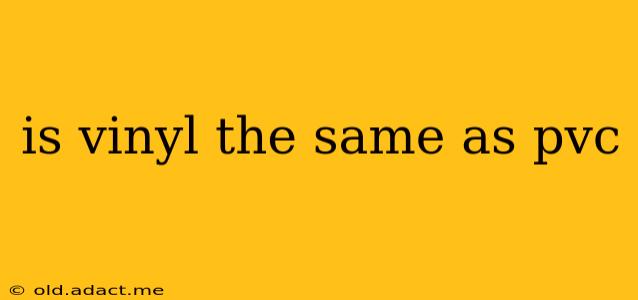The terms "vinyl" and "PVC" are often used interchangeably, leading to confusion. While closely related, they aren't exactly the same thing. Understanding the difference is crucial for making informed choices about products, from flooring to pipes. This article will clarify the relationship between vinyl and PVC, exploring their similarities, differences, and common applications.
What is PVC?
PVC, or polyvinyl chloride, is a specific type of plastic polymer. It's created through a polymerization process involving the monomer vinyl chloride. This process results in a strong, versatile, and relatively inexpensive material. PVC is known for its durability, resistance to chemicals, and its ability to be molded into various shapes and forms.
What is Vinyl?
"Vinyl" is a broader term often used as a general descriptor for products made from polyvinyl chloride (PVC) and other vinyl polymers. Think of it as an umbrella term encompassing various materials containing vinyl chloride monomers as a base. Many products labeled "vinyl" are primarily composed of PVC, but not always. Some vinyl products may also contain other additives, plasticizers, or stabilizers to enhance specific properties.
Are Vinyl and PVC the Same? The Key Difference
The core difference lies in the scope of the terms. PVC is a specific type of plastic, while vinyl is a more general term referring to products made from PVC and other vinyl-based polymers. All PVC is vinyl, but not all vinyl is PVC. The confusion arises because many common products made from PVC are simply called "vinyl" for simplicity's sake.
Why the interchangeable use?
The interchangeable usage of "vinyl" and "PVC" stems from the overwhelming dominance of PVC within the vinyl product market. PVC is by far the most common type of vinyl polymer used in consumer products. This leads to a blurring of the lines in everyday language.
What Products are Made from PVC (often called Vinyl)?
PVC's versatility makes it ideal for a wide array of applications:
- Flooring: Vinyl flooring, including sheet vinyl, vinyl tile, and luxury vinyl plank (LVP), is popular for its affordability and durability.
- Pipes and Fittings: PVC pipes are widely used in plumbing and drainage systems due to their corrosion resistance and strength.
- Window Frames: PVC is a common material for window frames because of its weather resistance and low maintenance.
- Clothing and Accessories: Some synthetic leathers and other clothing items incorporate PVC or vinyl-based polymers.
- Medical Devices: PVC's biocompatibility makes it suitable for certain medical applications.
- Packaging: PVC films and sheets are used in food packaging and other applications.
What are the Different Types of Vinyl?
While PVC dominates the vinyl market, other vinyl-based polymers exist, with varying properties and applications. These differences are often reflected in the specific product names and characteristics.
What are some vinyl products that aren't primarily PVC?
While hard to pinpoint specific examples without detailed product composition, some vinyl-based materials used in specialized applications (like adhesives or certain coatings) might use other vinyl polymers alongside or instead of PVC. This information is usually found in product specification sheets, which are not always readily available to consumers.
Is Vinyl Toxic? Addressing Common Concerns
The toxicity of vinyl, and specifically PVC, is a frequently asked question. The answer is complex. While PVC itself isn't inherently toxic, the manufacturing process and certain additives used in some PVC products can raise concerns. Plasticizers like phthalates, used to make PVC more flexible, have been linked to health problems in some studies. However, many manufacturers now utilize phthalate-free alternatives. It's crucial to look for products that specify phthalate-free or low-VOC (volatile organic compounds) formulations.
Conclusion
In short, while "vinyl" and "PVC" are often used interchangeably, they represent different concepts. PVC is a specific type of plastic, while vinyl is a broader category encompassing PVC and other vinyl polymers. Understanding this distinction allows for more informed decision-making regarding the purchase and use of products containing these materials. Remember to always check product labels and specifications for details about composition and potential health concerns.
